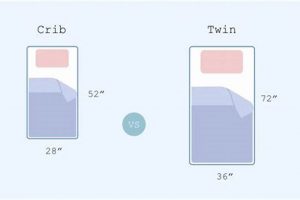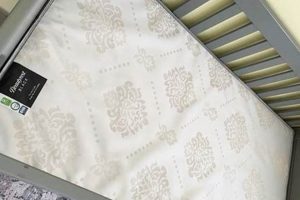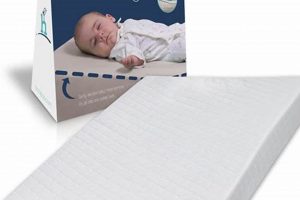The dimensions of a sleep surface designed for infants differ significantly from that intended for older children and adults. Specifically, the shorter and narrower form factor of the former contrasts sharply with the greater length and width characteristic of the latter. The former, for example, typically measures approximately 28 inches wide and 52 inches long, while the latter is approximately 38 inches wide and 75 inches long.
These dimensional distinctions are critical for ensuring infant safety, as the snug fit within a crib prevents entrapment hazards. The larger option, conversely, offers the necessary space and support for the developing bodies of older children and adolescents. This difference is rooted in developmental needs and safety standards established to protect vulnerable age groups.
Understanding these variations is the first step in choosing appropriate sleep surfaces for children. Subsequent sections will delve into the specific applications, advantages, and considerations involved in selecting between smaller and larger sleep surfaces, and related bedding, for different stages of childhood development.
Considerations for Selecting Sleep Surfaces
Selecting the appropriate sleep surface requires careful consideration of several factors to ensure safety, comfort, and adequate support for the individual.
Tip 1: Measure Available Space: Before acquiring any sleep surface, accurately measure the dimensions of the intended area. This prevents overcrowding and ensures sufficient room for movement around the bed.
Tip 2: Prioritize Safety Standards: Verify that the chosen sleep surface adheres to established safety regulations and certifications. This is particularly crucial for infant and toddler sleep surfaces.
Tip 3: Assess Support Needs: Consider the weight and developmental stage of the user. Infants require firm, flat surfaces, while older children may benefit from slightly softer options.
Tip 4: Evaluate Material Composition: Examine the materials used in the sleep surface construction. Opt for hypoallergenic and non-toxic materials to minimize potential allergic reactions or chemical exposure.
Tip 5: Check for Firmness and Stability: Ensure the sleep surface is firm and stable, preventing sagging or unevenness that could compromise posture and comfort.
Tip 6: Consider Long-Term Use: If possible, anticipate future needs and choose a sleep surface that can accommodate growth and changing requirements.
Tip 7: Research Bedding Compatibility: Ensure that bedding, such as sheets and blankets, are appropriately sized and compatible with the chosen sleep surface to prevent hazards like loose bedding.
These considerations collectively contribute to creating a safe and comfortable sleep environment, promoting restful sleep and healthy development.
With a foundational understanding of appropriate choices, the next step involves investigating other related considerations.
1. Dimensions
The dimensional disparity is a primary differentiating factor. A crib mattress adheres to regulated standards, typically measuring approximately 28 inches in width and 52 inches in length. This regulated dimension is crucial for safety, designed to fit snugly within a standard crib frame, minimizing the risk of infant entrapment. Conversely, a twin mattress exhibits significantly larger dimensions, approximately 38 inches wide and 75 inches long. This larger size accommodates the physical needs of older children and adults, providing ample space for comfortable sleep and movement.
The practical significance of these differing dimensions is evident in real-life scenarios. Attempting to use a twin mattress within a crib is impossible due to size incompatibility, rendering the crib unsafe. Conversely, placing a smaller sleep surface, intended for a crib, on a twin bed frame creates hazardous gaps, posing a risk of falling or entrapment. For instance, a family expecting a new baby will purchase a crib and a crib mattress of specified dimensions to ensure their infant’s secure sleep. Then a few years later, they’ll buy a twin mattress for their growing child’s first ‘big kid’ bed.
In summary, the dimensional differences between these sleep surfaces are paramount, dictating their suitability for specific age groups and preventing safety hazards. Understanding these disparities is fundamental for selecting appropriate sleep solutions and ensuring a safe sleep environment. Any deviation from these dimensions could lead to serious safety consequences.
2. Safety Standards
Adherence to safety standards is a paramount consideration when evaluating the difference between a sleep surface designed for infants and one intended for older children. The dimensional specifications for the former are rigidly controlled to prevent hazards such as entrapment within a crib frame. These regulations dictate not only the external dimensions but also mandate specific material properties and construction techniques. The intent is to minimize the risk of suffocation, strangulation, or injury resulting from inadequate support or the presence of harmful chemicals. Twin mattresses, on the other hand, are subject to different safety protocols primarily addressing flammability and structural integrity, reflecting the anticipated use by older individuals. For example, federal regulations specify strict flammability standards for all mattresses sold in the United States, but the emphasis on size and fit is particularly acute when considering items designed for infants.
The cause and effect relationship between these safety standards and the choice of a sleep surface is direct. Failure to comply with prescribed standards, such as using a non-compliant mattress, can have severe consequences. One example is the use of a homemade or repurposed mattress within a crib; such alternatives often deviate significantly from standard sizes, creating gaps between the mattress and the crib frame. This, in turn, presents an entrapment hazard, as an infant may become wedged in the gap, leading to serious injury or even death. Therefore, selecting mattresses that meet or exceed current safety regulations is crucial for ensuring the well-being of the infant.
In summary, safety standards are integral to the selection of appropriate sleep surfaces. Strict dimensional and material requirements for infant items are designed to minimize specific risks associated with that developmental stage. While other mattresses are subject to safety standards related to flammability and durability, the precise fit and construction of infant products demand rigorous adherence to established regulations. The understanding and application of these safety requirements are essential for creating a secure sleep environment and safeguarding the health of young children.
3. Intended Use
The concept of “intended use” is central to differentiating sleep surfaces. The needs of an infant are vastly different from those of an older child or adult, and this dictates appropriate design.
- Infant Development and Safety
Sleep surfaces for infants prioritize safety and support proper physical development. A firm surface is crucial to reduce the risk of Sudden Infant Death Syndrome (SIDS). A smaller size is employed to ensure a snug fit within the crib, minimizing the risk of entrapment. As an illustration, a newborn spending the majority of their time sleeping requires a firm and flat surface to facilitate proper bone development and avoid postural issues.
- Toddler Transition and Growth
As children transition from infancy to toddlerhood, their needs evolve. A crib can become restrictive as they gain mobility and independence. While transitioning out of a crib, a twin can serve as a great transition option. The twin form factor provides room to accommodate growth and increased movement during sleep.
- Child and Adolescent Comfort
Twin size can provide comfort. Children need enough space to be comfortable.
In summary, the intended use informs mattress size, material composition, and safety features. Failure to recognize these distinctions can have implications for sleep quality and safety. Therefore, selecting an item appropriate for its intended use is a crucial step in furnishing a sleep environment that aligns with individual needs.
4. Lifespan
The expected lifespan of a sleep surface is directly related to its design, materials, and intended use. An item intended for infant use, designed to fit within a crib, typically has a shorter lifespan compared to a sleep surface intended for older children and adults. This disparity arises from several factors, including the rapid growth rate of infants, which quickly renders a smaller sleep surface inadequate, and the varying use patterns between the two age groups. For example, while a toddler might need a bigger bed if they outgrow their crib, an adult will maintain their twin bed for many years.
The materials used in the construction also play a role in determining lifespan. Infant sleep surfaces are often constructed with specific materials designed to meet stringent safety standards, such as being hypoallergenic and resistant to bacterial growth. However, these materials may not be as durable as those used in items intended for older individuals, leading to a shorter overall lifespan. In contrast, a mattress for older children is more likely to be constructed using more durable innerspring systems or high-density foam, allowing for longer-term use. The product’s lifespan is linked to the overall cost-effectiveness of different options. While a higher-priced twin mattress might represent a larger initial investment, its longer lifespan can result in lower cost-per-year compared to a cheaper crib mattress that needs frequent replacement.
In summary, the lifespan of a sleep surface must be carefully considered alongside factors such as intended use, materials, and safety standards. While crib mattresses are designed for a relatively short period of intensive use during infancy, mattresses for older children are intended for longer-term use, necessitating a different approach to material selection and construction. Understanding these factors allows consumers to make informed purchasing decisions that balance safety, comfort, and long-term value.
5. Cost
The financial outlay associated with sleep surfaces differs substantially based on size and intended use. Products designed for infant use, while physically smaller, may not always represent a lower overall cost. Specific safety standards and material requirements often drive up the price of these items. The expense includes stringent testing and certification processes required to ensure compliance with regulations aimed at protecting vulnerable age groups. Conversely, a mattress intended for older children and adults, despite its larger size, may offer a wider range of price points, reflecting variations in materials, construction techniques, and brand reputation. The consequence of these factors is that cost becomes a significant consideration, influencing purchase decisions.
A real-world example illustrates the impact of cost considerations. A family preparing for a new arrival might find that a crib mattress meeting all safety certifications costs nearly as much as a basic twin mattress. However, the infant-specific product is deemed essential due to safety requirements. As the child transitions into a toddler bed, the family may opt for a more budget-friendly twin mattress, foregoing higher-end features to manage expenses. The practical significance of this dynamic lies in the need to balance safety, comfort, and affordability when selecting sleep solutions for different stages of child development.
In summary, the economic considerations are an integral component in selecting appropriate sleep surfaces. While infant-specific items may incur higher costs due to safety standards, the wider range of options for older children allows for greater flexibility in managing budgets. Balancing these financial implications with considerations for safety, comfort, and longevity is essential for making informed purchasing decisions and ensuring a safe and restful sleep environment.
6. Bedding Availability
Bedding availability is intrinsically linked to sleep surface dimensions. The specific form factor of infant and toddler products necessitates specially sized sheets, blankets, and mattress protectors not interchangeable with those designed for larger beds. Cause-and-effect: selecting a crib mattress requires ensuring the availability of appropriately sized linens for safe usage. Its importance is highlighted by safety concerns, where ill-fitting bedding increases the risk of suffocation. Example: a standard sized product would require bedding specifically manufactured for it, while a twin item would also requires its own.
Availability can directly affect purchase decisions. Standard bedding can provide cost effective alternatives with the right size. Inconvenient sizing can cause difficulty in aquiring them.
In summary, the practical significance of bedding availability, tied to sleep surface dimensions, lies in safety and convenience. Ensuring appropriate bedding is readily accessible ensures safe and functional.
7. Room Space
The size of a room directly influences the selection of sleep surfaces. The spatial constraints within a nursery often necessitate the use of a crib and, consequently, a crib mattress. A larger bedroom, in contrast, may readily accommodate a twin bed, offering greater sleeping space. This interrelationship highlights the cause-and-effect dynamic: limited square footage restricts options to smaller, space-saving solutions, whereas ample space permits a wider range of choices. Room Space is, therefore, a fundamental component in decisions regarding sleep surfaces, dictating whether a crib mattress is a practical and necessary choice or whether a twin bed is a feasible alternative.
For instance, families residing in apartments or smaller homes frequently prioritize cribs and their corresponding smaller-sized mattresses due to limited room space. This decision, while practical from a spatial perspective, also requires acknowledging that the item will likely need to be replaced as the child grows, potentially incurring additional costs and logistical considerations. Conversely, a family with a larger home may opt for a twin bed from the outset, potentially delaying the need for future sleep surface replacements, but also requiring a greater initial allocation of room space. Considerations of room space extend beyond just the bed. The amount of room available will affect how much room there is available for other essential furniture pieces like a dresser, desk or play area.
In summary, the allocation of room space constitutes a critical factor when considering dimensions of sleep surfaces. The dimensions of room directly impact the feasibility of various options, influencing decisions based on practical spatial considerations and long-term planning. Balancing space limitations with developmental needs and financial constraints is paramount in creating an effective and functional sleeping environment that maximizes available square footage while promoting comfort and safety.
Frequently Asked Questions About Crib Mattress Size vs Twin
The following addresses common queries regarding appropriate sleep surfaces for children.
Question 1: Can a twin mattress be used in a crib?
No. A twin mattress is significantly larger than a crib mattress, rendering it unsuitable for use in a standard crib. Utilizing a non-standard mattress poses a serious entrapment hazard for infants.
Question 2: What are the standard dimensions of a crib mattress?
A standard crib mattress measures approximately 28 inches wide and 52 inches long. These dimensions are regulated to ensure a snug fit within a crib frame.
Question 3: At what age should a child transition from a crib to a twin bed?
The transition from a crib to a bed is dependent on individual development rather than a fixed age. A child typically transitions when they begin climbing out of the crib or express discomfort in the confined space, generally between 18 months and 3 years old.
Question 4: Are the safety standards the same for crib mattresses and twin mattresses?
No. Safety standards for products designed for infant use, including crib mattresses, are more stringent than those for twin mattresses. The enhanced safety standards are designed to minimize risks to infants.
Question 5: Is a firmer or softer mattress preferable for infants?
A firmer mattress is recommended for infants to reduce the risk of Sudden Infant Death Syndrome (SIDS). Soft mattresses can conform to the infant’s face, potentially obstructing breathing.
Question 6: Can a used crib mattress be safely used for a new baby?
The use of a used crib mattress is not generally recommended. Over time, mattresses can degrade and harbor bacteria or allergens. If a used mattress must be used, it should be thoroughly inspected for signs of wear or damage.
Careful consideration of these factors is critical for ensuring the safety and comfort of children. Understanding the distinctions between sleep surfaces allows consumers to make informed choices and create a secure sleep environment.
With these questions addressed, the next section examines methods for purchasing bedding.
Crib Mattress Size vs Twin
This exploration has elucidated the fundamental differences between infant-specific sleep surfaces and those designed for older children. The distinct dimensions, safety standards, intended uses, lifespans, costs, bedding availability, and spatial considerations underscore the importance of careful evaluation. The snug fit and stringent safety protocols of crib mattresses serve to protect infants from entrapment and suffocation. The greater dimensions and varying support levels of twin mattresses cater to the evolving physical needs of growing children. The disparities between “crib mattress size vs twin” are dictated by necessity, reflecting safety, developmental requirements and spatial practicalities.
The foregoing insights are intended to inform responsible purchasing decisions. Recognizing the distinct attributes of “crib mattress size vs twin” allows for the creation of safe, comfortable, and developmentally appropriate sleep environments, contributing to the well-being of children. Further research into material composition and manufacturing processes is encouraged to ensure informed and conscientious selections that align with individual needs and preferences.


![Best Mattress Portable Crib [Review & Guide] Organic & Natural Mattress Buyer’s Guide: Non-Toxic Sleep Solutions Best Mattress Portable Crib [Review & Guide] | Organic & Natural Mattress Buyer’s Guide: Non-Toxic Sleep Solutions](https://mattressworldpa.com/wp-content/uploads/2025/07/th-1302-300x200.jpg)

![Best Compact Crib Mattress Size Guide: [Year] Organic & Natural Mattress Buyer’s Guide: Non-Toxic Sleep Solutions Best Compact Crib Mattress Size Guide: [Year] | Organic & Natural Mattress Buyer’s Guide: Non-Toxic Sleep Solutions](https://mattressworldpa.com/wp-content/uploads/2025/07/th-1300-300x200.jpg)


